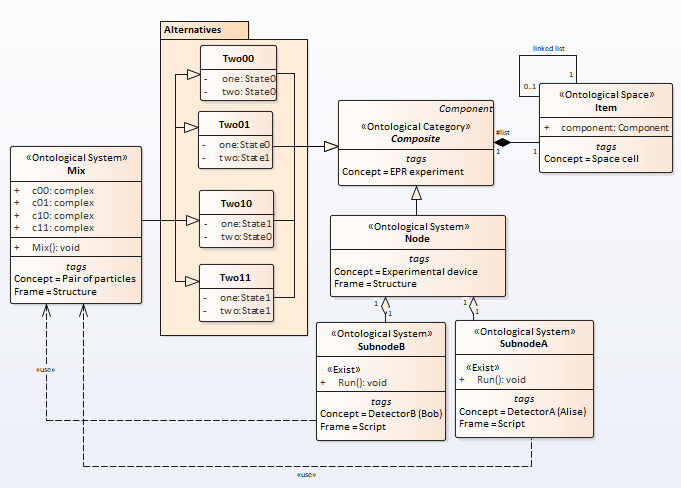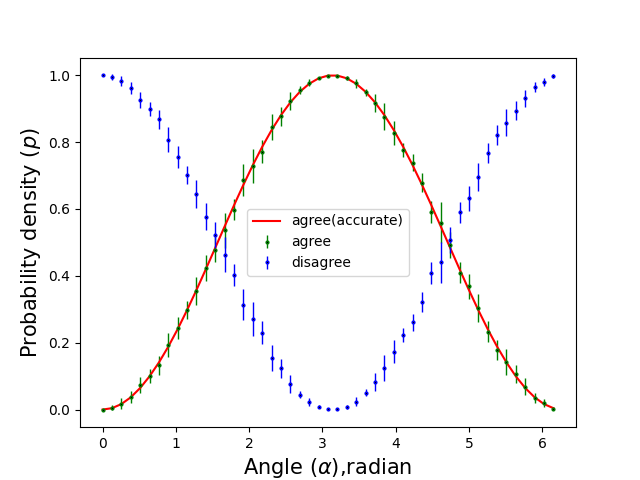Home
Ontologies in QM
View the Project on GitHub vgurianov/qm
1. Key points
• Wave function• Superposition
2. Main quantum effects
• Double-slit experiment• Uncertainty principle
• Entanglement
• Bell’s test
3. Other quantum models
• Rutherford scattering I• Rutherford scattering II
• Spin
• Turing machine
• Non-numerical models
• Discussion
Appendix
• Measurement error• Complex nambers
• Metaprogramming in Python
Bell’s test
1. Matematical discription
Consider an analogue of the Stern-Gerlach experiment. Stern-Gerlach devices \(P_1\) and \(P_2\) are located along the same axis and can rotate around this axis. Orient the \(P_1\) device along the \(Z\) axis and leave it untouched. We will rotate the device \(P_2\) around the \(X\) axis at different angles \(\alpha\). For each angle value, we obtain a series of EPR pairs and calculate the probabilities of different outcomes, as well as the probabilities \(P(match), P(diff)\).
The formulas for these probabilities will look like
\begin{eqnarray}
P(+,-)] = \frac{1}{2} \cos^2 (\frac{\alpha}{2}) \nonumber \
P(-,+)] = \frac{1}{2} \cos^2 (\frac{\alpha}{2}) \nonumber \
P(+,+)] = \frac{1}{2} \sin^2 (\frac{\alpha}{2}) \
P(-,-)] = \frac{1}{2} \sin^2 (\frac{\alpha}{2}) \nonumber \
P(math)] = \frac{1}{2} \sin^2 (\frac{\alpha}{2}) \nonumber \
P(diff)] = \frac{1}{2} \cos^2 (\frac{\alpha}{2}) \nonumber
\end{eqnarray}
Bell’s inequality has the form
\begin{equation} \frac{N[A^+,B^+]}{N} \leq \frac{N[B^-,C^-]}{N} + \frac{N[A^+,C^+]}{N} \end{equation},
here \(N[...]/N\) is the frequency of the corresponding configuration. From the point of view of the theory of hidden variables, this inequality must be satisfied for any directions A, B, C.
From the point of view of quantum mechanics, we have
\begin{eqnarray}
\frac{N[A^+,B^+]}{N} \approx P[A^+,B^+] = \frac{1}{18} \sin^2 (\frac{AB}{2}) \nonumber \
\frac{N[B^-,C^-]}{N} \approx P[B^-,C^-] = \frac{1}{18} \sin^2 (\frac{BC}{2})
\frac{N[A^+,C^+]}{N} \approx P[A^+,C^+] = \frac{1}{18} \sin^2 (\frac{AC}{2}) \nonumber
\end{eqnarray}
and inequality 11 will be written
\begin{equation} \sin^2 (\frac{AB}{2}) \leq \sin^2 (\frac{BC}{2}) + \sin^2 (\frac{AC}{2}) \end{equation}
There are such mutual orientations of the directions A, B, C for which this inequality does not hold.
2. Semantic Net Describtion
Bell’s test as a semantic net is depicted in the picture Fig.  Fig.7. The Bell’s test model
Fig.7. The Bell’s test model
The dependence of the probability density on the angle of rotation is shown in Fig. \ref{fig:fig8}
 Fig.8. The probability density of the angle
Fig.8. The probability density of the angle
The complete code is here https://github.com/vgurianov/qm/software/bell.py.
We will use the same model as in section 5, only now the angle will take three values AB = 240° BC = 60° AC = 300° randomly. The experiment measured the number of events and showed the inequality
\begin{equation}
N[A^+,B^+] \leq N[B^-,C^-] + N[A^+,C^+]
\end{equation}
Experiment result is depicted in table 2
| № | \(AB\) | \(BC\) | \(AC\) | \(N[A^+,B^+] <\) | \(N[B^-,C^-]+N[A^+,C^+]\) |
|---|---|---|---|---|---|
| 1 | 240° | 60° | 300° | 15 | 11 |
| 2 | 240° | 60° | 300° | 15 | 11 |